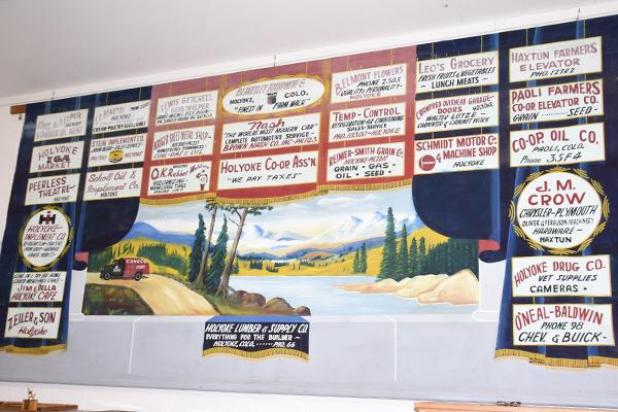
One of the larger pieces at Phillips County Museum, this stage curtain was one housed at the McKelvey School, District No. 12. It was a one-room school located 8 miles south and 1 mile east of Paoli, and the curtain was there from 1952-1961, when the school was discontinued. — Johnson Publications
Family business leaves advertising legacy; locals remember curtain at McKelvey School
A 65-year-old painted theater curtain housed at the Phillips County Museum recently caught the attention of Curtains Without Borders, a Vermont organization dedicated to finding, documenting and caring for historic stage scenery nationwide.
On a local level, advertisements on the same curtain remind residents of businesses that have come and gone, and the curtain itself is remembered by some who performed or watched plays set against it.
Hilda Hassler, vice president of the Phillips County Historical Society, jumped at the opportunity to talk about the stage curtain. She remembers the first- through eighth-grade school in which it originally hung. McKelvey School, District No. 12, was located 8 miles south and 1 mile east of Paoli, Hassler recalled.
According to “Those were the Days...” the first McKelvey School was a one-room frame building. In 1952, the new McKelvey building was block and stucco with running water and restrooms. After the school was discontinued in 1961, the building was used as a Grange Hall for a time.
Hassler attended the old McKelvey School and was the only student in her year. She graduated from there the year before the new building began being used and the curtain was installed.
Gary Sperber, who attended McKelvey until 1954 when he went on to Holyoke High School, said that each year the students put on a play or two, prompted by the teacher. For those plays, the painted curtain was used as a backdrop.
One of the more memorable plays, he noted, happened at Christmas time. One student was delivering “Twas the Night Before Christmas” and was struck with a case of the hiccups that had everyone laughing. He also recalled the traditional box suppers that accompanied the plays at McKelvey. Women would prepare food and put it in a decorated box. The boxes of food were then auctioned off at the school.
Sperber had already graduated from high school by the time McKelvey closed, but he thought that the curtain ought to be preserved somehow. When the school was being sold, Sperber arranged for the curtain to be donated to the museum.
In the mid 1900s, such curtains could be found in many schools. They were often painted with a scene in the middle surrounded by advertisements. Since businesses paid for advertising space, the curtain was free to the school. Advertisements were generally sold for $15-$45, depending on the size, and that covered the cost of materials, installation and expenses.
Visitors to the museum in Holyoke will notice a few familiar names among the advertisers. The Peerless Theatre and Scholl Oil & Implement Co. are two that have stood the test of time. Others have changed ownership, merged or gone out of business.
According to material printed by Curtains Without Borders, curtain sites were often revisited after a while to see if a new, updated one was needed. “Local businesses came and went so quickly that curtains could be out-of-date within a decade,” it said.
Curtains Without Borders visits Colorado
In May 2016, Christine Hadsel, project director of Curtains Without Borders, visited Colorado, where she studied historic painted curtains around the state.
One of her stops was at Phillips County Museum to view its curtain. One of the project goals is to assess the condition of various curtains and provide education about how to best conserve them. At some sites, they help make repairs and create a plan to better conserve the curtain.
In Phillips County, the museum was commended for their care of the curtain and received only minor pointers for taking even better care of it.
In Colorado, they have documented 30 curtains in 20 different communities including Yuma and Julesburg. “I expect these curtains are just a few among many that we still don’t know about,” Hadsel said. According to the historical society, Fairfield School also had a similar curtain, which was sold recently at an auction.
Nationwide, Curtains Without Borders has documented over 500 curtains and conserved over 300.
The full article is available in our e-Edition. Click here to subscribe.
